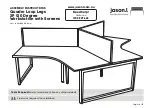
When arranged horizontally, both operators act as
carriers. (They both produce sound.) The V50 has four
operators. When these four operators are arranged in
various ways, each operator acts either as a carrier or
as a modulator as shown in the following diagram.
“M” indicates that the operator acts as a modulator
“C” indicates that the operator acts as a carrier
When all operators are arranged horizontally, each one
acts as a carrier. When all operators are arranged ver-
tically, the lowest one acts as a carrier and the other three
act as modulators.
Algorithm
An arrangement of operators is called an “algorithm”.
The V50 has eight algorithms. These eight algorithms
(numbered 1 – 8) are shown on the right side of the front
panel. Each operator ‘in an algorithm is numbered 1 – 4.
Page 40 explains the characteristic sounds possible with
each algorithm.
Factors determining the tone of a voice
There are many settings that affect the tone of a voice,
but the following six are the most important.
(1) Algorithm (ALGORITHM)
It is important to choose an appropriate algorithm for
the sound you want to create. This selection determines
whether each operator acts as a carrier or as a modulator.
(2) Output level of each operator
(OUTPUT LEVEL)
The output level of a carrier operator will determine
volume, and the output level of a modulator operator
will determine the brightness of the sound produced by
the operator (carrier) it is modulating.
The output levels of operators A and
B determine the mixture (balance) of the
two sounds.
Modulator
Carrier
The output level of operator B determines
the brightness of the sound produced by
operator A. The output level of operator
A determines the volume.
Pitch of each operator
(OSCILLATOR FREQUENCY)
The resulting tone is affected by the relative pitch of the
operators.
Waveform of each operator
Each operator can produce one of 8 different waveforms.
Each waveform has a different harmonic content (a
different tone), allowing you to select the most suitable
waveform for the sound you want.
Envelope generator (ENVELOPE GENERATOR)
All instruments (piano, organ, brass, etc.) have a char-
acteristic rise and fall in the sound. To simulate this,
each operator has a function that regulates its output
over time. This is known as the “envelope generator”,
or “EG” for short.
It will take a bit of practice to use these six elements to
create the sound you want, but as you become more
experienced you will find that creating voices enjoyable
and rewarding.
Voice Edit
37
Summary of Contents for V50
Page 1: ...YAMAHA AUTHORIZED PRODUCT MANUAL DIGITAL SYNTHESIZER ...
Page 2: ...DIGITAL SYNTHESIZER Operating Manual YAMAHA ...
Page 4: ...DIGITAL SYNTHESIZER ...
Page 130: ...Initialized performance settings SNGL 4LYR DUAL 8LYR Appendix 125 ...
Page 131: ...SPLT SEQ4 126 Appendix SEQ8 Initialized voice settings ...
Page 140: ...135 ...
Page 141: ... Table 2 136 ...
Page 142: ... Table 3 137 ...
Page 143: ...138 ...
Page 144: ...139 ...
Page 145: ...140 Table 4 ...
Page 160: ...YAMAHA VG87090 89 01 1 5 CR R1 Printed in Japan YAMAHA CORPORATION P O Box 1 Hamamatsu Japan ...
















































